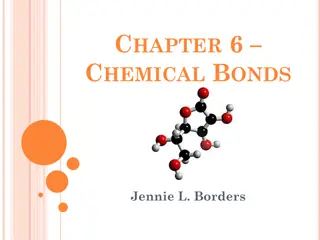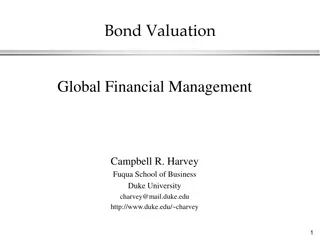Understanding Complex Ions and Coordinate Bonds in Chemistry
Complex ions in chemistry are formed when transition metals or their ions bond with ligands through coordinate bonds. Ligands utilize their lone pairs of electrons to form dative covalent bonds with transition metals, determining the coordination number of the cation. Complex ions play a crucial role in various chemical reactions, with examples including [Cu(H2O)6]2+. Unidentate ligands, such as H2O, Cl-, NH3, and CN-, form single coordinate bonds in coordination complexes. The concept of coordination numbers, different types of ligands, and the formation of coordinate bonds are essential in the study of complex ions and transition metal chemistry.
Download Presentation

Please find below an Image/Link to download the presentation.
The content on the website is provided AS IS for your information and personal use only. It may not be sold, licensed, or shared on other websites without obtaining consent from the author. Download presentation by click this link. If you encounter any issues during the download, it is possible that the publisher has removed the file from their server.
E N D
Presentation Transcript
Key Word Complex Ion Definition Metal ion surrounded by co-ordinately bonded ligands Coordinate Bond A covalent bond in which both electrons in the shared pair come from the same atom The number of coordinate bonds to ligands that surround a transition metal ion An ion or molecule that forms a coordinate bond with a transition metal Ligand that can only form one coordinate bond Ligand that can form two coordinate bonds Coordination Number - Ligand Unidentate Bidentate Multidentate Ligands that can form more than one coordinate bond
COMPLEXES Complexes are formed when transition metals or their ions form co-ordinate (dative) bonds with ligands A complex ion is an ion comprising of one or more ligands attached to a central metal cation by means of a dative covalent bond Cations are positive ( pussy-tive) ions
LIGANDS A ligand is a species which can use its lone pair of electrons on one of its atoms to form a dative covalent bond with a transition metal Examples of ligands are: H2O NH3 Cl- OH- CN-
CO-ORDINATE BOND A co-ordinate bond (dative covalent bond) is a covalent bond in which both electrons come from the same atom In the case of complex ions, the co-ordinate bonds are formed by the overlap of an orbital containing a lone pair of electrons with a vacant orbital on the transition metal
CO-ORDINATION NUMBER The number of lone pairs of electrons which a cation can accept is known as the coordination number of the cation It depends on the size and electronic configuration of that cation, and also on the size and charge of the ligand Coordination number 6 is the most common, although 4 and 2 are also known
EXAMPLE An example of a complex ion is: [Cu(H2O)6]2+ Note that the formula of the ion is always written inside square brackets H2O H2O OH2 Cu2+ The overall charge is written outside the brackets H2O OH2 OH2
UNIDENTATE LIGANDS Meaning single toothed form 1 co-ordinate bond Common unidentate ligands are H2O, Cl-, NH3 and CN- Can be negatively charged ions or neutral molecules Ammonia only has 1 pair of electrons to donate Water has 2 lone pairs. BUT they are so close together it can only form one coordinate bond at a time!
BIDENTATE LIGANDS Ligands that can form two co-ordinate bonds since they donate two lone pairs of electrons (from two donor atoms) Each ethane-1,2-diamine molecule forms 2 coordinate bonds with the metal ion Examples: Ethane-1,2-diamine (NH2CH2CH2NH2) 2 amine groups. Each has a lone pair of electrons to donate
MULTIDENTATE LIGANDS Can form three or more co-ordinate bonds by donating at least three lone pairs of electrons to the metal ion Extremely stable since the reaction results in an increase in entropy Ethylenediaminetetracetate EDTA is a common example How many coordinate bonds can it form?
EDTA4- has six lone pairs (two on nitrogen atoms and 4 on oxygen atoms) It can form six coordinate bonds with a metal ion Complex ions with multidentate ligands are called chelates ( key- lates) from the Greek word for claw
MULTIDENTATE LIGANDS [Cu(H2O)6]2+ + EDTA [Cu(EDTA)]2- + 6H2O They can be used to remove metal ions from solution The six water ligands are replaced by one EDTA ligand This results in an increase in the number of particles in solution Hence an increase in entropy
TYPES OF LIGAND The charge on the ligand and the oxidation state of the metal determines the overall charge of the complex Neutral ligands result in positively charged complexes, where the overall charge of the complex equals the oxidation state of the metal ion Negatively charged ligands result in a negatively charged complex
OXIDATION STATES Overall charge on a complex ion is its total oxidation state It s put outside the brackets You can work out the oxidation state of the metal ion by: Oxidation state of metal ion Total oxidation state of complex Sum of oxidation states of ligands = -
OXIDATION STATES Back to this example: [Cu(H2O)6]2+ Overall = 2+ H2O ligands 12 H s = +12 6 O s = -12 Cu2+ ion has an oxidation state of +2 H2O H2O OH2 Cu2+ H2O OH2 Cu2+ ion has a co-ordination number of 6 OH2
QUESTIONS Work out the oxidation states (OS) and co-ordination numbers (CN) of the following complexes: [Cu(H2O)6]2+ OS: +2 CN:6 [Ag(NH3)2]+ OS: +1 CN:2 [Cu(NH3)4]2+ OS: +2 CN:4 [Cu(Cl)4]2- OS: +2 CN:4 [Fe(CN)6]3- CN OS = -1 OS: +3 CN:6
SHAPES OF COMPLEXES The co-ordination number dictates the shape of the complex This is the number of coordinate bonds formed with the central metal ion 2 co-ordinate = linear 4 co-ordinate = tetrahedral 6 co-ordinate = octahedral
SIX COORDINATE BONDS Use the molymods to create each complex molecule & draw it in your notes Make the one below and then try [Co(NH3)6]3+ Octahedral shape 6 points BUT 8 faces
FOUR COORDINATE BONDS Usually have a tetrahedral shape A few complexes have a square planar shape Cisplatin (Pt(NH3)2Cl2) is an example
TWO COORDINATE BONDS Most have a linear shape E.g. [Ag(NH3)2]+ A solution of this is called Tollens reagent which is used to tell aldehydes from ketones. Aldehydes reduce it to silver, while ketones do not
USEFUL APPLICATIONS OF EDTA EDTA has many uses, for example: An antidote in metal poisoning. It removes poisonous metal ions (e.g. mercury and lead) from the bloodstream It is an anticoagulant, so is used in blood transfusions to remove calcium ions which cause blood clotting, and in the storage and analysis of blood in forensic science To remove calcium ions from hard water. For this reason many cleaning products contain it, such as shampoos, shower gel etc
HAEMOGLOBIN Blood naturally contains a multidentate ligand called haemoglobin The haemoglobin molecule contains 4 nitrogen atoms that are co-ordinately bonded to iron Two more co-ordinate bonds are formed to the iron, one from the nitrogen atom in the protein globin and the other from the oxygen in a molecule of oxygen (oxyhaemoglobin) or from a water molecule (deoxyhaemoglobin)
HAEMOGLOBIN This complex transports the oxygen in our blood around our bodies, due to the weak co- ordinate bonds formed in the iron complex Carbon monoxide can also form co-ordinate bonds with the complex and the bond is more stable than the bond formed with oxygen. Therefore if carbon monoxide is breathed in and concentration is high enough, it can cause oxygen starvation to the body and is life threatening
CISPLATIN One of the most-successful anti-caner drugs developed in recent years is cisplatin It is believed to work by bonding to DNA so that it prevents the replication of cancerous cells Its isomer transplatin has no anti-cancer properties
HOW IT WORKS Bonds between guanine on separate strands of DNA are coordinate ones with nitrogen These displace the two ammonia molecules from cisplatin the platinum atom is now binded to DNA bases This prevents DNA from unravelling which it needs to do in order for replication (cancer is uncontrollable cell replication The damaged DNA elicits DNA repair mechanisms, which in turn activate apoptosis (cell death) when repair proves impossible.
I CAN Define the terms ligand, co-ordinate bond and co- ordination number Explain what unidentate, bidentate and multidentate ligands are I AM C B Calculate co-ordination numbers and oxidation states and shapes of complex ions Give examples of each type of ligand and analyse some of their applications A A*
NAMING COMPOUNDS The name contains: a) The ligand b) The number of ligands c) The oxidation state of the transition metal ion Ligand Name in Complex Formula Charge Water aqua H2O Cl- 0 Chloride chloro -1 Ammonia amine NH3 CN- 0 Cyanide cyano -1 Hydroxide Hydroxo OH- -1
NAMING COMPLEXES The number of ligands has a prefix Number of ligands 2 4 6 Prefix di tetra hexa If more than one ligand is present, they are named alphabetically ignoring the prefix
NAMING COMPLEXES When a complex is cationic the name of the metal is as you would expect it Name in anionic Cobaltate Chromate Vanadate Cuprate Ferrate Metal When a complex is an anionic, the metal name ends in ate Cobalt Chromium Vanadium Copper Iron The oxidation state of the metal is given in roman numerals.
Questions Work out the name of the following complexes: [Cu(H2O)6]2+ [Co(Cl)4]2- [Cr(NH3)6]2+ [Ag(NH3)2]+ [Co(H2O)6]2+ [Cu(Cl)4]2- [Ag(Cl)2]- hexaaquacopper (II) tetrachlorocobaltate(II) hexaaminechromium(II) diaminesilver(I) hexaaquacobalt(II) tetrachlorocuprate(II) dichloroargentate(I)























